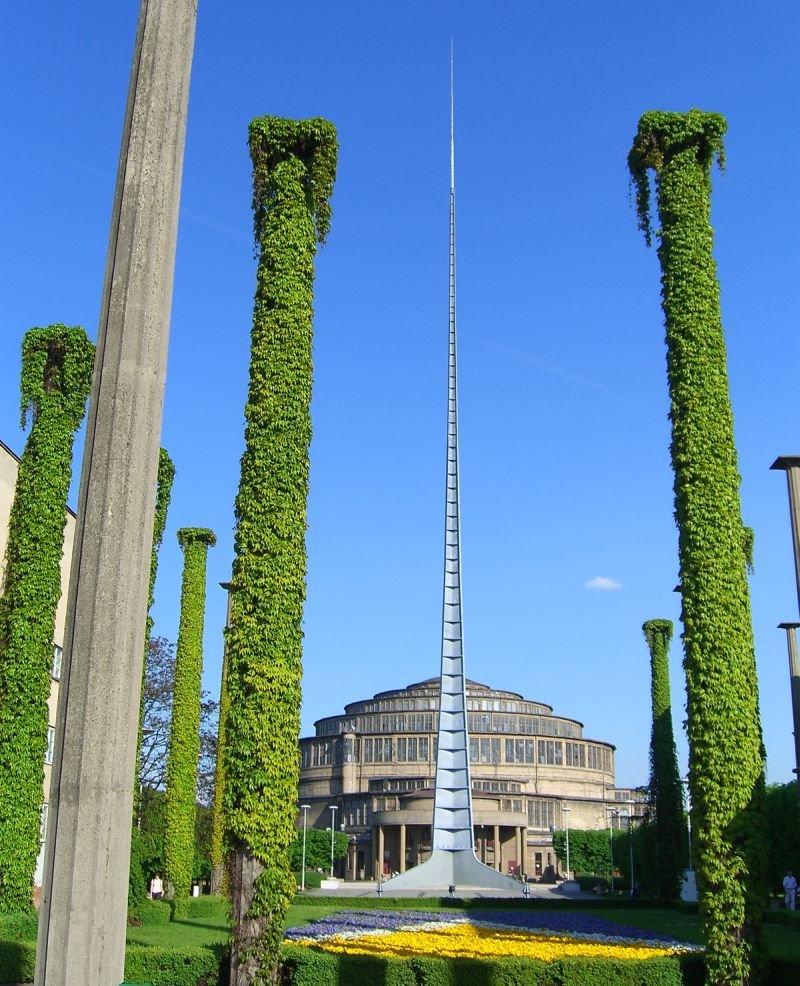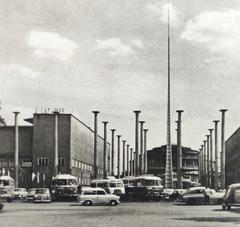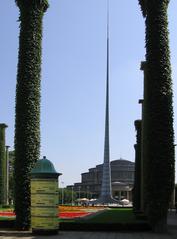
Iglica Wrocław: Visiting Hours, Tickets, and Historical Significance
Date: 15/06/2025
Introduction
The Iglica in Wrocław, Poland, is a landmark that epitomizes the city’s resilience, architectural ambition, and rich cultural tapestry. Erected in 1948 as the centerpiece of the Regained Territories Exhibition, this needle-like steel spire stands adjacent to the renowned UNESCO-listed Centennial Hall, creating a unique dialogue between early 20th-century modernism and post-war innovation. Today, the Iglica is not only a symbol of Wrocław’s rebirth after World War II but also a vibrant hub for cultural events, public gatherings, and artistic inspiration. This guide provides a comprehensive overview of the Iglica’s history, visiting hours, ticketing, accessibility, nearby attractions, and practical tips for an enriching visit.
Historical Background and Significance
Origins and Context
The Iglica (“Spire” or “Needle”) originated in the aftermath of World War II, a period marked by dramatic territorial changes and the rebuilding of Wrocław, formerly Breslau. Following the city’s transfer from Germany to Poland, the government organized the Regained Territories Exhibition in 1948 to celebrate national unity, technological progress, and the integration of formerly German territories into Poland. The Iglica was designed by Stanisław Hempel as the exhibition’s focal point, symbolizing the city’s rebirth and the collective spirit of its new residents (halastulecia.pl; en.wikipedia.org).
Architectural Design and Symbolism
Standing initially at 106 meters, the Iglica was a feat of modernist engineering, constructed from steel and weighing approximately 44 tons. Its slender, ribbed form was conceived to contrast sharply with the Centennial Hall’s massive dome and to embody the ideals of modernity and progress. The three-legged base of the Iglica represents the unity of Poland’s workers, peasants, and intelligentsia—an emblem of postwar social solidarity (halastulecia.pl).
Construction and Technical Details
Construction began in spring 1948 and concluded in time for the exhibition’s July opening. The Iglica’s original design included a set of mirrors at its tip, intended to reflect searchlights as a dazzling nighttime feature. However, a severe thunderstorm shortly before the exhibition damaged the top, leading to the removal of the mirrors and the bent tip in a daring rescue operation by pioneering mountaineers (pl.wikipedia.org; tvn24.pl).
Modifications and Conservation
Over the years, the Iglica has undergone several structural adjustments. In 1965, corrosion necessitated the removal of its uppermost section, reducing its height to 96 meters, and later conservation work brought it to its current 90.3 meters. The spire has been periodically repainted and restored to ensure longevity and safety (pl.wikipedia.org; wroclaw.pl).
Cultural and Political Impact
Beyond its architectural value, the Iglica is a powerful political and cultural symbol. It has hosted public events, served as a platform for artistic installations, and even been used for political statements, such as the display of the Tibetan flag. Its location in front of Centennial Hall highlights Wrocław’s layered history, bridging German-era modernism with Polish postwar identity (halastulecia.pl; tvn24.pl).
Visitor Information
Location and Accessibility
The Iglica is situated on Wystawowa Street, in the eastern part of Wrocław, adjacent to Centennial Hall and within the scenic Szczytnicki Park. It is easily reachable by tram, bus, bicycle, or on foot, with stops like “Hala Stulecia” and “Zoo” nearby. Several parking lots serve the area, though they may fill up during major events (Journey of Exploration).
The plaza around the Iglica is wheelchair accessible, with smooth paths and ramps. Facilities such as public restrooms and bicycle racks are available, and the area is well-lit and patrolled for safety.
Visiting Hours
The Iglica stands in an open public space and is accessible 24/7, year-round. There are no official opening or closing hours, making it convenient for visitors at any time. Special lighting displays and events may occur during evenings or festivals.
Tickets and Entry Fees
There is no admission fee or ticket required to visit the Iglica or explore the surrounding plaza. Access to nearby attractions—such as Centennial Hall, the Japanese Garden, or the Museum of Contemporary Art—may require separate tickets, which can be purchased online or at the venues (Wroclaw Guide).
Best Time to Visit
Late spring and early autumn are ideal for visiting, offering mild weather and blooming gardens. Summer brings vibrant outdoor events but also larger crowds, while winter offers a quieter atmosphere, especially after snowfall. Sunrise and sunset provide dramatic lighting for photography, and nighttime visits may coincide with special illuminations (Destination Abroad).
Travel Tips
- Public Transport: Trams and buses efficiently connect the city center with the Iglica. Ticket machines may not always accept cards, so carry cash or use mobile payments.
- Cycling: The city’s Nextbike network provides convenient bicycle rentals.
- Weather: Wrocław’s weather can be unpredictable; pack an umbrella or rain jacket.
Nearby Attractions
- Centennial Hall (Hala Stulecia): A UNESCO World Heritage Site, renowned for its architectural innovation and cultural events (en.wikipedia.org).
- Japanese Garden: A tranquil oasis ideal for relaxation and photography.
- Pergola and Multimedia Fountain: The colonnaded Pergola surrounds a fountain that hosts spectacular light and water shows in warmer months.
- Szczytnicki Park: One of the largest city parks, perfect for walks and picnics.
- Wrocław Zoo: A family-friendly destination within walking distance.
Events and Activities
The Iglica area is a lively venue for cultural events:
- Giełda Staroci: One of Poland’s oldest flea markets, held on select weekends beneath the Iglica (PIK Wrocław).
- Concerts and Festivals: The plaza hosts open-air concerts, art installations, and seasonal festivals. Multimedia Fountain shows are a highlight from spring to autumn.
- Guided Tours: Many city tours include the Iglica and Centennial Hall, offering context on modernist architecture and Wrocław’s history.
Photography and Sightseeing Tips
- Best Photo Spots: Capture the Iglica’s full height from the Pergola or Multimedia Fountain. Dawn and dusk offer exceptional lighting.
- Drone Photography: Permitted under local regulations; avoid flying over crowds or events.
- Nighttime Views: Special illuminations during city celebrations create dramatic photo opportunities.
Safety, Regulations, and Etiquette
- Safety: The area is generally safe and well-patrolled. Exercise standard urban caution during crowded events.
- Regulations: Climbing the Iglica is prohibited for safety reasons. Public alcohol consumption is restricted except in designated zones.
- Cultural Etiquette: Politeness is appreciated. Learn basic Polish greetings, and always ask before photographing people during private events (Key to Poland).
Accessibility for International Visitors
Wrocław is part of the Schengen Area, allowing visa-free visits for most travelers from the EU, USA, Canada, and Australia for up to 90 days. EU citizens may enter with a national ID card; others require a valid passport. English is widely spoken at major tourist sites (Journey of Exploration).
Frequently Asked Questions (FAQ)
What are Iglica’s visiting hours?
The Iglica is accessible 24/7 as it is located in an open public plaza.
Is there an entry fee or ticket required to visit Iglica?
No, visiting the Iglica and its immediate surroundings is free.
Can I climb the Iglica?
No, climbing is strictly prohibited for safety reasons.
Are guided tours available?
Yes, many walking and cycling tours include the Iglica as part of a broader exploration of Wrocław’s architectural history.
Is the Iglica area wheelchair accessible?
Yes, the plaza and nearby attractions are equipped with ramps and smooth pathways.
Can I take drone photos at Iglica?
Drone photography is allowed, provided local regulations are followed and crowds are avoided.
Summary and Recommendations
The Iglica is a must-see among Wrocław’s historical and architectural sites, embodying the city’s spirit of resilience, unity, and forward-looking creativity. Its 24/7 accessibility, free entry, and proximity to major attractions such as Centennial Hall and the Japanese Garden make it an essential stop for visitors. From seasonal events and flea markets to stunning photo opportunities, the Iglica area offers a dynamic experience for all. For the best visit, check local event calendars, weather forecasts, and consider downloading the Audiala app for personalized tips and guided tours.
Embrace Wrocław’s rich history and vibrant culture by including the Iglica in your itinerary, and enjoy one of Poland’s most remarkable urban landscapes.
Sources and Further Reading
- Iglica (Wrocław), Wikipedia
- Iglica - Halastulecia.pl
- Centennial Hall (Wrocław), Wikipedia
- Centennial Hall - WroclawExplorer.com
- Iglica (Wrocław) - Polish Wikipedia
- Iglica History and Symbolism, TVN24.pl
- WikiArquitectura - Centennial Hall in Wrocław
- PIK Wrocław - Giełda Staroci Events
- Journey of Exploration - Things to do in Wrocław
- Wroclaw Guide - History and Events
- Destination Abroad - Is Wrocław Worth Visiting?
- Key to Poland - Travel Tips for Poland















































